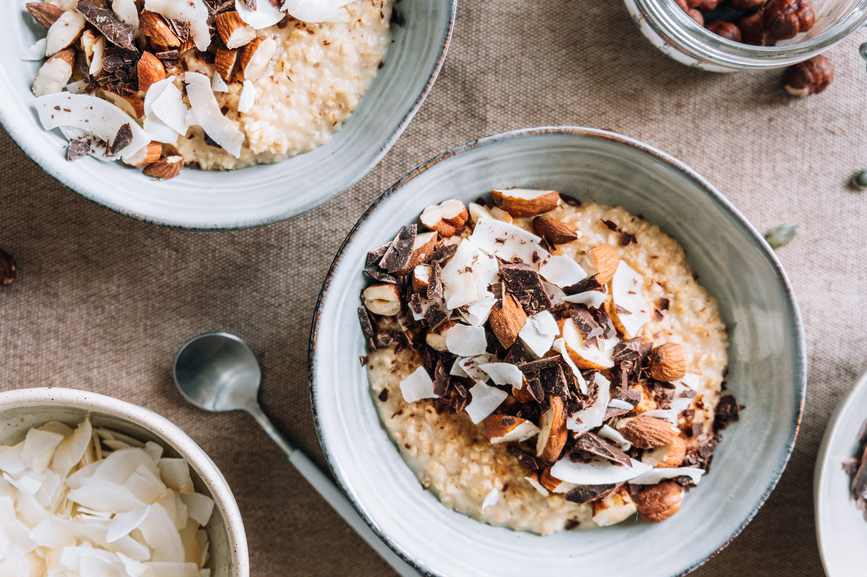- Will Bulsiewicz, MD, South Carolina-based gastroenterologist and author of Fiber Fueled
“Hopefully, you’ve been hearing the exciting news about fiber. What we once thought was the boring roughage that makes grandma poop has undergone a science-fueled renaissance,” begins Will Bulsiewicz, MD, a board-certified gastroenterologist and New York Times bestselling author of books that dive into the bountiful benefits of fiber. In other words, the thick and unpalatable fiber supplements of yesteryear are making way for a greater emphasis on fiber-rich, plant-based whole foods—and none too soon.
“[Fiber] is good for our gut microbiome, is a precursor to anti-inflammatory short chain fatty acids, and has been linked to health benefits throughout the body,” Dr. Bulsiewicz continues. With that said, the word fiber itself is a catch-all term that encompasses a much broader and more diverse family of nutrients. It exists in many forms, and one that doesn’t get a ton of airtime—until now, that is—is arabinoxylans.
What are arabinoxylans?
Truth be told, while I’ve been a consistent champion of fiber in various forms—insoluble and soluble, fruits and veggies, whole foods and supplements—for several years running, I hadn’t heard of arabinoxylans until recently. In short, they’re a specific type of fiber found in various grains. (Sit tight, as we’ll get to the specifics of their top food sources shortly.)
The benefits of arabinoxylans
“Much like other forms of fiber, arabinoxylans appear to be prebiotic, which means that they enhance the growth of beneficial gut microbes and improve human health,” Dr. Bulsiewicz says.
Now, recall his earlier mention that fiber is a precursor to short chain fatty acids. “We know that short chain fatty acids like butyrate are particularly beneficial for gut health because they enhance the growth of anti-inflammatory microbes, suppress the inflammatory microbes, and repair the intestinal barrier to reverse leaky gut,” he continues. As far as the connection to arabinoxylans is concerned, the GI expert references a randomized, double-blind, placebo-controlled study in 40 healthy human volunteers, which found that participants who ate arabinoxylan-enriched bread increased their butyrate levels and the presence of anti-inflammatory microbes. Equally impressive is the fact that those who ate this enriched bread reported no adverse GI symptoms.
Dr. Bulsiewicz takes care to note that research on the benefits of arabinoxylans is relatively new, so there’s a lot we don’t yet know. Still, he points out a few recent studies demonstrating their additional benefits that go beyond improvements in gut health. Take, for instance, a 2022 study conducted at Stanford University, in which “researchers found that arabinoxylan supplementation was beneficial for lowering LDL cholesterol. These benefits were likely due to the changes that occured in the gut microbiome,” he shares.
Another study that shows the promising potential of arabinoxylans is a 2016 randomized control trial consisting of healthy young adults. Those who ate arabinoxylan-rich wheat bran at night “improved blood glucose control and insulin sensitivity,” says Dr. Bulsiewicz, which indicates that diets rich in these fibers have the potential to improve glucose tolerance in generally healthy populations.
The best food sources of arabinoxylans
Again, these fibers are most commonly found in grains. “You will find arabinoxylans most represented in foods like wheat, corn, rye, barley, rice, and oats,” Dr. Bulsiewicz shares—which is great news if you already prioritize these foods in your diet. Additional natural food sources of arabinoxylans include the likes of psyllium, flax seed, pangola grass, bamboo shoots, rye grass, and even white-flour pasta.
With this info in mind, the GI doc says that it’s still important to fill up on a diverse range of fibrous foods in our diets, which most definitely includes fruits and veggies. “There isn’t yet enough evidence to say that we should be targeting arabinoxylans instead of other forms of dietary fiber,” says Dr. Bulsiewicz, “but there is clearly enough evidence to support the health benefits of dietary fiber, with one of the beneficial forms being arabinoxylans.”
Remember: Fiber is your friend, and there are countless healthy (and tasty!) options to choose from to get more of it in your diet. Dr. Bulsiewicz mentions that “49 out of 50 Americans are inadequately consuming whole grains,” which emphasizes our collective need to include more of them—and thus arabinoxylans—in our meals. Yet at the same time, he reiterates that the majority of us could benefit from boosting our total intake fiber, as “19 out of 20 Americans are deficient in their fiber consumption.” Yikes.
In order to get these statistics trending in a better direction, Dr. Bulsiewicz concludes by stating that “we should make it a goal to consume a diverse mix of plant foods to reap the rewards of a fiber-rich, prebiotic-powered diet.” In due time, your gut *and* your greater health will thank you by demonstrating just how friendly fiber can be.
